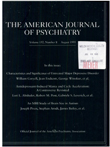Impaired startle prepulse inhibition and habituation in patients with schizotypal personality disorder
Abstract
OBJECTIVE: Information processing measures that serve as biological markers for schizophrenia can help to define the boundaries of schizophrenia. Prepulse inhibition and habituation of the blink reflex component of startle, which are thought to reflect an individual's ability to screen out or "gate" irrelevant sensory stimuli, are impaired in patients with schizophrenia. These deficits in sensorimotor gating and habituation in schizophrenic patients may lead to sensory overload and, secondarily, cognitive fragmentation, disorganization, and thought disorder. The goal of this study was to test two hypotheses: 1) patients with schizotypal personality disorder would show a loss of sensorimotor gating reflected by impaired prepulse inhibition of the human startle response and 2) patients with schizotypal personality disorder would show deficits in startle habituation consistent with the deficits seen in patients with schizophrenia. METHOD: Prepulse inhibition and habituation were assessed in 12 men and four women who met DSM-III-R criteria for schizotypal personality disorder and in 22 normal comparison subjects. RESULTS: Patients with schizotypal personality disorder had deficits in acoustic prepulse inhibition and habituation similar to the deficits observed in patients with schizophrenia. Although there were no differences between patients with schizotypal personality disorder and normal subjects in latency from acoustic startle stimuli to response, latency facilitation was produced by the prepulse in both groups. CONCLUSIONS: This pattern of changes in amplitude and latency of the startle response suggests that subjects with schizotypal personality disorder perceive the prepulse stimuli but still demonstrate deficient sensorimotor gating of amplitude. These findings support the importance of startle prepulse inhibition and startle habituation as biological markers for schizophrenia spectrum disorders.
Access content
To read the fulltext, please use one of the options below to sign in or purchase access.- Personal login
- Institutional Login
- Sign in via OpenAthens
- Register for access
-
Please login/register if you wish to pair your device and check access availability.
Not a subscriber?
PsychiatryOnline subscription options offer access to the DSM-5 library, books, journals, CME, and patient resources. This all-in-one virtual library provides psychiatrists and mental health professionals with key resources for diagnosis, treatment, research, and professional development.
Need more help? PsychiatryOnline Customer Service may be reached by emailing [email protected] or by calling 800-368-5777 (in the U.S.) or 703-907-7322 (outside the U.S.).



